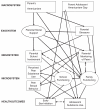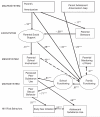An empirical test of ecodevelopmental theory in predicting HIV risk behaviors among Hispanic youth
- PMID: 20130302
- PMCID: PMC3715967
- DOI: 10.1177/1090198109349218
An empirical test of ecodevelopmental theory in predicting HIV risk behaviors among Hispanic youth
Abstract
Ecodevelopmental theory is a theoretical framework used to explain the interplay among risk and protective processes associated with HIV risk behaviors among adolescents. Although ecodevelopmentally based interventions have been found to be efficacious in preventing HIV risk behaviors among Hispanic youth, this theory has not yet been directly empirically tested through a basic research study in this population. The purpose of this cross-sectional study was to empirically evaluate an ecodevelopmentally based model using structural equation modeling, with substance use and early sex initiation as the two outcomes of the ecodevelopmental chain of relationships. The sample consisted of 586 Hispanic youth (M age = 13.6; SD = 0.75) and their primary caregivers living in Miami, Florida. Adolescent, parent, and teacher reports were used. The results provided strong support for the theoretical model. More specifically, the parent-adolescent acculturation gap is indirectly related both to early sex initiation and to adolescent substance use through family functioning, academic functioning, perceived peer sexual behavior, and perceived peer substance use. Additionally, parent's U.S. orientation is associated with adolescent substance use and adolescent sex initiation through social support for parents, parental stressors, family functioning, academic functioning, and perceived peer sexual behavior and substance use. These findings suggest that HIV risk behaviors may best be understood as associated with multiple and interrelated ecological determinants.
Figures
Similar articles
-
Ecodevelopmental predictors of early initiation of alcohol, tobacco, and drug use among Hispanic adolescents.J Sch Psychol. 2015 Jun;53(3):195-208. doi: 10.1016/j.jsp.2015.02.001. Epub 2015 Mar 24. J Sch Psychol. 2015. PMID: 26054814 Free PMC article.
-
Ecodevelopmental x intrapersonal risk: substance use and sexual behavior in Hispanic adolescents.Health Educ Behav. 2009 Feb;36(1):45-61. doi: 10.1177/1090198107311278. Epub 2008 Mar 6. Health Educ Behav. 2009. PMID: 18326053 Free PMC article.
-
Do parent-adolescent discrepancies in family functioning increase the risk of Hispanic adolescent HIV risk behaviors?Fam Process. 2014 Jun;53(2):348-63. doi: 10.1111/famp.12067. Epub 2014 Mar 11. Fam Process. 2014. PMID: 24617745 Free PMC article. Clinical Trial.
-
The role of families in adolescent HIV prevention: a review.Clin Child Fam Psychol Rev. 2000 Jun;3(2):81-96. doi: 10.1023/a:1009571518900. Clin Child Fam Psychol Rev. 2000. PMID: 11227063 Review.
-
A review of bidimensional acculturation and STI/HIV-related sexual risk behaviours among Hispanic youth.Cult Health Sex. 2023 Oct;25(10):1259-1276. doi: 10.1080/13691058.2022.2154387. Epub 2022 Dec 29. Cult Health Sex. 2023. PMID: 36579632
Cited by
-
Associations between Parent-Child Communication on Sexual Health and Drug Use and Use of Drugs during Sex among Urban Black Youth.Int J Environ Res Public Health. 2021 May 13;18(10):5170. doi: 10.3390/ijerph18105170. Int J Environ Res Public Health. 2021. PMID: 34068128 Free PMC article.
-
Randomized effectiveness trial of a parent and youth combined intervention on the substance use norms of Latino middle school students.J Subst Abuse Treat. 2019 Feb;97:75-83. doi: 10.1016/j.jsat.2018.11.012. Epub 2018 Nov 27. J Subst Abuse Treat. 2019. PMID: 30577903 Free PMC article. Clinical Trial.
-
Theories of Change and Mediators of Psychotherapy Effectiveness in Adolescents With Externalising Behaviours: A Systematic Review.Front Psychiatry. 2022 Jan 14;12:730921. doi: 10.3389/fpsyt.2021.730921. eCollection 2021. Front Psychiatry. 2022. PMID: 35095586 Free PMC article.
-
Psychosocial and Cultural Processes Underlying the Epidemiological Paradox within U.S. Latino Sexual Risk: A Systematic Review.Behav Sci (Basel). 2023 Mar 5;13(3):226. doi: 10.3390/bs13030226. Behav Sci (Basel). 2023. PMID: 36975251 Free PMC article. Review.
-
Relationship between chronotype and mental behavioural health among adolescents: a cross-sectional study based on the social ecological system.BMC Psychiatry. 2023 Jun 6;23(1):404. doi: 10.1186/s12888-023-04879-6. BMC Psychiatry. 2023. PMID: 37280607 Free PMC article.
References
-
- Achenbach TM, Dumenci L, Rescorla LA. Is American student behavior getting worse? Teacher ratings over an 18-year period. School Psychology Review. 2002;31:428–442.
-
- Barnes HL, Olson DH. Parent-adolescent communication and the Circumplex Model. Child Development. 1985;56:438–447.
-
- Bernstein R. U.S. Hispanic population surpasses 45 million now 15 percent of total. U.S. Census Bureau News; May 1, 2008.
-
- Bean RA, Barber BK, Crane DR. Parental support, behavioral control, and psychological control among African American youth. Journal of Family Issues. 2006;27:1335–1355.
MeSH terms
Grants and funding
LinkOut - more resources
Full Text Sources
Medical
Miscellaneous



